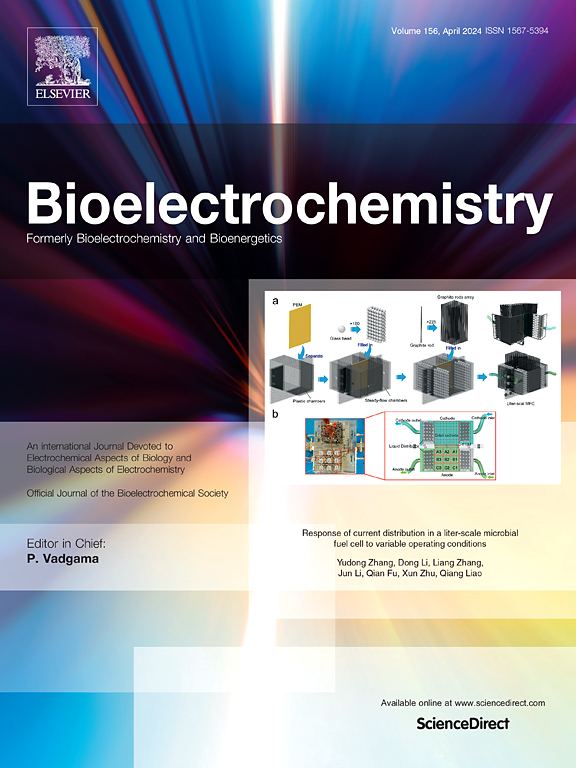Interfacial extracellular electron uptake is linked to nitrate respiration in the marine heterotroph, Thalassospira xiamenensis SN3
IF 4.8
2区 化学
Q1 BIOCHEMISTRY & MOLECULAR BIOLOGY
引用次数: 0
Abstract
Thalassospira species are ubiquitous marine bacteria with poorly understood ecology, and some have been implicated in iron corrosion. To better elucidate the mechanisms and ecological implications of extracellular electron transfer (EET) in oxidative processes, we conducted genomic and bioelectrochemical characterization of Thalassospira xiamenensis strain SN3, an obligate heterotroph isolated from coastal marine sediment cathode-oxidizing enrichments. Physiologic and genomic analyses indicate that SN3 lacks the capacity for lithoautotrophic growth and lacks homologs to genes canonically involved in EET. Bioelectrochemical characterization of SN3 cells shows that inward EET requires a terminal electron acceptor (respiration). Deletion of nitrate reductase catalytic subunit napA abolished current consumption and catalytic activity under nitrate-reducing conditions. Media exchange experiments demonstrate that inward EET in SN3 is facilitated by direct contact with the electrode, with a formal midpoint potential of −153 ± 16 mV vs. SHE. Through deletion of the formate dehydrogenase fdhABCD and electrochemical characterization of mutant cells, we show that inward EET is not a function of Fdh enzyme sorption to the electrode, as has been demonstrated for other organisms. This provides further evidence of a cell-mediated and contact-dependent EET mechanism. This work provides a foundation for investigating this metabolically versatile organism's yet uncharacterized mechanism of EET.
海洋异养藻厦门海螺旋体SN3的界面胞外电子吸收与硝酸盐呼吸有关
海螺旋体是一种普遍存在的海洋细菌,其生态学知之甚少,其中一些与铁腐蚀有关。为了更好地阐明氧化过程中细胞外电子转移(EET)的机制和生态学意义,我们对从沿海海洋沉积物阴极氧化富集中分离出来的专性异养型盐螺旋体(Thalassospira ximenensis) SN3菌株进行了基因组学和生物电化学表征。生理和基因组分析表明,SN3缺乏石自养生长的能力,也缺乏与EET相关的基因的同源性。SN3细胞的生物电化学表征表明,向内的EET需要一个终端电子受体(呼吸)。硝酸还原酶催化亚基napA的缺失使硝酸盐还原条件下的电流消耗和催化活性降低。介质交换实验表明,与电极直接接触有助于SN3中的内向EET,与SHE相比,其正式中点电位为- 153±16 mV。通过删除甲酸脱氢酶fdhABCD和突变细胞的电化学表征,我们发现内向EET不是Fdh酶吸附到电极的功能,这在其他生物体中得到了证明。这进一步证明了细胞介导和接触依赖的EET机制。这项工作为研究这种代谢多样的生物尚未明确的EET机制提供了基础。
本文章由计算机程序翻译,如有差异,请以英文原文为准。
求助全文
约1分钟内获得全文
求助全文
来源期刊

Bioelectrochemistry
生物-电化学
CiteScore
9.10
自引率
6.00%
发文量
238
审稿时长
38 days
期刊介绍:
An International Journal Devoted to Electrochemical Aspects of Biology and Biological Aspects of Electrochemistry
Bioelectrochemistry is an international journal devoted to electrochemical principles in biology and biological aspects of electrochemistry. It publishes experimental and theoretical papers dealing with the electrochemical aspects of:
• Electrified interfaces (electric double layers, adsorption, electron transfer, protein electrochemistry, basic principles of biosensors, biosensor interfaces and bio-nanosensor design and construction.
• Electric and magnetic field effects (field-dependent processes, field interactions with molecules, intramolecular field effects, sensory systems for electric and magnetic fields, molecular and cellular mechanisms)
• Bioenergetics and signal transduction (energy conversion, photosynthetic and visual membranes)
• Biomembranes and model membranes (thermodynamics and mechanics, membrane transport, electroporation, fusion and insertion)
• Electrochemical applications in medicine and biotechnology (drug delivery and gene transfer to cells and tissues, iontophoresis, skin electroporation, injury and repair).
• Organization and use of arrays in-vitro and in-vivo, including as part of feedback control.
• Electrochemical interrogation of biofilms as generated by microorganisms and tissue reaction associated with medical implants.
 求助内容:
求助内容: 应助结果提醒方式:
应助结果提醒方式:


